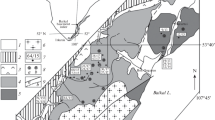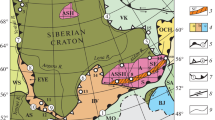Abstract
It was shown that the contents of Ni, Mo, and Co in the siliceous clay black shale rocks of the normal sections of the Bazhenov Formation are several times higher than the global mean contents of these elements in black shales. These rocks have the highest contents of pyrite and organic carbon and show evidence for strongly reducing formation conditions at the slowest background rate of sedimentation of their material. A transition from the siliceous clay rocks to the mudstones of normal section, which are considered as turbidites, and further to the mudstones and clayey silt rocks of the so-called anomalous sections (deposits of submarine deltas and canyons) is accompanied by sequential depletion in pyrite and organic carbon, a decrease in indicators of the reduction level of the sedimentation environment, and an increase in sedimentation rate and clay material content. Simultaneously, the contents of the elements of interest decreases in the sequence Mo > Ni > Co. In the rocks of anomalous sections, the contents of these elements decrease to the level of their mean abundances in clays.
Similar content being viewed by others
References
T. J. Algeo and T. W. Lyons, “Mo–total organic carbon covariation in modern anoxic marine environments: Implications for analysis of paleoredox and paleohydrographic conditions,” Paleoceanography 21, PA1016 (2006).
R. M. Coveney, Jr. and C. Nansheng, “Ni–Mo–PGE–Au-rich ores in Chinese black shales and speculations on possible analogues in the United States,” Mineral. Deposita 26 (2), 83–88 (1991).
Fan Delian, “Poly elements in the Lower Cambrian black shale series in Southern China,” The Significance of Trace Metals in Solving Petrogenetic Problems and Controversies, Ed. by S.S. Augustithis (Theophrastus Publications, Athens, 1983), pp. 447–474.
V. M. Gavshin and V. A. Bobrov, “Tendencies of the trace element distribution in the Bazhenov Formation,” in Domanikites of Siberia and Their Role in the Petroleum Potential (SNIIGGiMS, Novosibirsk, 1982), pp. 76–91 [in Russian].
V. M. Gavshin and F. G. Gurari, “Geochemistry of shale formations of Siberia,” in Geology of Carbonaceous and Combustible Shale Formations of Siberia, Ed. by V.S. Surkov (SNIIGGiMS, Novosibirsk, 1987), pp. 50–56.
V. M. Gavshin and V. A. Zakharov, “Geochemistry of the Upper Jurassic–Lower Cretaceous Bazhenov Formation, West Siberia,” Econ. Geol. 91 (1), 122–133 (1996).
V. M. Goldschmidt, “The principles of distribution of chemical elements in minerals and rocks,” J. Chem. Soc. 140, 655–673 (1937).
F. G. Gurari, V. Ya. Vaits, V. N. Melenevskii, V. I. Moskvin, G. N. Perozio, E. A. Predtechenskaya, D. I. Rudnitskaya, O. F. Stasova, V. Kh. Frolov, and V. A. Frolova, Conditions of Formation of Methods of Petroleum Search in the Mudstones of the Bazhenov Formation (Nedra, Moscow, 1988) [in Russian].
H. L. O. Huyck, “When is a mettalliferous black shale not a black shale?,” in Metalliferous Black Shales and Related Ore Deposits. Proceedings, 1989 United States Working Group Meeting, International Geological Correlation Project 254, U.S. Geol. Surv. Circ. No. 1058, 42–56 (1990).
M. P. Ketris and Ya. E. Yudovich, “Estimations of clarkes for carbonaceous biolithes: world averages for trace element contents in black shales and coals,” Int. J. Coal. Geol. 78 (1), 135–148 (2009).
M. M. Kolganova and A. E. Kontorovich, “Some features of the vanadium and nickel geochemistry in the sedimentary rocks and oils,” in Geology of the Petroleum Areas of the West Siberian Lowland, Ed. by F.G. Fotiadi (SNIIGGiMS, Novosibirsk, 1966), pp. 184–197.
A. E. Kontorovich, “Geochemistry of the Upper Jurassic sediments of the West Siberian Plate,” Litol. Miner. Res., No. 3, 90–102 (1967).
A. E. Kontorovich, V. L. Berman, L. I. Bogorodskaya, B. G. Vinokur, M. M. Kolganova, L. F. Lipnitskaya, N. M. Mel’nikova, O. F. Stasova, and A. S. Fomichev, Geochemistry of Jurassic and Lower Cretaceous Sediments of the West Siberian Lowlands (Nedra, Moscow, 1971) [in Russian].
S. G. Krasnov, S. A. Lebedev, and T. V. Dorofeeva, “Tendencies in composition variations of the rocks of the Bazhenov Formation of West Siberia,” in Domanikites of Siberia and Their Role in the Petroleum Potential (SNIIGGiMS, Novosibirsk, 1982), pp. 32–43 [in Russian].
H. Kucha, “Platinum-group metals in the Zechstein copper deposits, Poland,” Econ. Geol., 77 (6), 1578–1591 (1982).
K. Loukola-Ruskeeniemi and H. Lahtinen, “Multiphase evolution in the black-shale-hosted Ni–Cu–Zn–Co deposit at Talvivaara, Finland,” Ore Geol. Rev. 52, 85–99 (2013).
J. Pašava, B. Kříbek, K. Žák, Li Chaoyang, Deng Hailin, Liu Jiajun, Gao Zhenmin, Luo Taiji, and Mingguo Zeng “Environmental impacts of mining of Ni–Mo black shale-hosted deposits in the Zunyi region, southern China: Preliminary results of the study of toxic metals in the system rock–soil–plant,” Bull. Geosci. 78 (3), 251–263 (2003).
R. L. Poulson Brucker, J. McManusi, and W. S. Poulton, “Molybdenum isotope fractionations observed under anoxic experimental conditions,” Geochem. J. 46 (3), 201–209 (2012).
R. Raiswell and J. A. Plant, “The incorporation of trace elements into pyrite during diagenesis of black shales, Yorkshire, England,” Econ. Geol. 75 (5), 684–699 (1980).
R. Raiswell, F. Buckley, R. A. Berner, and T. F. Anderson, “Degree of pyritization of iron as a paleoenvironmental indicator of bottom-water oxygenation,” J. Sediment. Petrol. 58 (5), 812–819 (1988).
O. M. Rosen and Yu. A. Nistratov, “Determination of mineral composition of sedimentary rocks from chemical analysis,” Sov. Geologiya, No. 3, 76–83 (1984).
K. K. Turekian and K. H. Wedepohl, “Distribution of the elements in some major units of the Earth’s crust,” Geol. Soc. Am. Bull. 72 (2), 175–192 (1961).
I. N. Ushatinskii, “Major and trace-element composition of the rocks of the Bazhenov Formation and host clays,” in Association of Trace Elements with Organic Matter in Sedimentary Sequences of Siberia, Ed. by V.A. Kuznetsov (Inst. Geol. Geofiz. Sib. Otd. Ross. Akad. Nauk, Novosibirsk, 1984), pp. 21–31.
I. N. Ushatinskii and O. G. Zaripov, Mineralogical and Geochemical Indicators of the Petroleum Potential of the Mesozoic Sediments of the West Siberian Plate (Sredneural’sk. Kn. Izd., Sverdlovsk, 1978) [in Russian].
I. N. Ushatinskii, L. M. Gavrilova, and L. Ya. Volkova, “Geochemistry of major and minor elements of the Bazhenov Formation of the Middle Ob region,” in Geochemistry of Composite Petroleum Fields, Ed. by A.V. Ryl’kov (ZapSibNIGNI, Tymen, 1988), pp. 44–62 [in Russian].
J. D. Vine and Tourtelot, E. B. “Geochemistry of black shale deposits—a summary report,” Econ. Geol. 65 (3), 253–272 (1970).
E. N. Volkov, and L. N. Smertina, “Speciation of chalcophile elements in the rocks of the Bazhenov Formation,” in Association of Trace Elements with Organic Matter in the Sedimentary Sequences of Siberia, Ed. by V.A. Kuznetsov (Inst. Geol. Geofiz. Sib. Otd. Ross. Akad. Nauk, Novosibirsk, 1984), pp. 32–40 [in Russian].
Ya. E. Yudovich, and M. P. Ketris, Trace Elements in Black Shales (Naka, Yekaterinburg, 1994) [in Russian].
Yu. N. Zanin, A. G. Zamirailov, and V. G. Eder, “Some aspects of the formation of the Bazhenov Formation in the central areas of the West Siberian sedimentation basin,” Litosfera, No 4, pp 118–135 (2005).
Yu. N. Zanin, V. G. Eder, and A. G. Zamirailova, “Composition and formation environments of the Upper Jurassic–Lower Cretaceous black shale of the Bazhenov Formation (the central part of the West Siberian Basin,” Mar. Petrol. Geol. 25 (3), 289–306 (2008).
M. Yu. Zubkov, and N. A. Doronina, “Geochemistry of rocks of the Bazhenov Formation,” in Domanikites and Their Role in the Petroleum Potential, Ed. by F.G. Gurari (SNIIHHiMS, Novosibirsk, 1982), pp. 68–76.
Author information
Authors and Affiliations
Corresponding author
Additional information
Original Russian Text © Yu.N. Zanin, A.G. Zamirailova, V.G. Eder, 2017, published in Geokhimiya, 2017, No. 2, pp. 161–170.
Deceased.
Rights and permissions
About this article
Cite this article
Zanin, Y.N., Zamirailova, A.G. & Eder, V.G. Nickel, molybdenum, and cobalt in the black shales of the Bazhenov Formation of the West Siberian basin. Geochem. Int. 55, 195–204 (2017). https://doi.org/10.1134/S0016702917010116
Received:
Accepted:
Published:
Issue Date:
DOI: https://doi.org/10.1134/S0016702917010116




